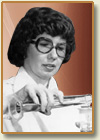Barbara Askins
Inventor of a New Film Developing Method

Established by the IPO Education Foundation, the National Inventor of the Year Award was created in 1974 to increase public awareness of the importance of technology to U.S. industry and the national economy. But it wasn't until five years later that an individual female inventor would take home the prize. That woman: NASA chemist Barbara Askins.
Though she began her career as a teacher, inventor Barbara Askins returned to school after having two children and received both bachelor's and master's degrees in chemistry. After completing her education, Askins went to work for NASA at the famed Marshall Space Flight Center, where she was charged with the task of inventing a way to improve astronomical and geological photos taken from space (which were often fuzzy and lacked definition). The solution she developed would have a greater impact than anyone could have imagined.
Barbara Askins' invention involved the use of radioactive materials to enhance negatives, which, as it turned out, could also be used to enhance images even after the pictures had been developed. After patenting the invention in 1978 (U.S. patent No. 4,101,780), Askins' method was put to use by NASA with great success. In fact, Askins invention was so successful that it was adopted outside of the agency for a variety of other uses, including improving the clarity of x-rays and restoring old photographs. For her invention of a new way of developing film, Askins was honored as the National Inventor of the Year in 1978.
For more information on NASA chemist Barbara Askins, refer to:

Inventor of the Week: Barbara Askins
Great Images in NASA: Barbara Askins, Chemist



